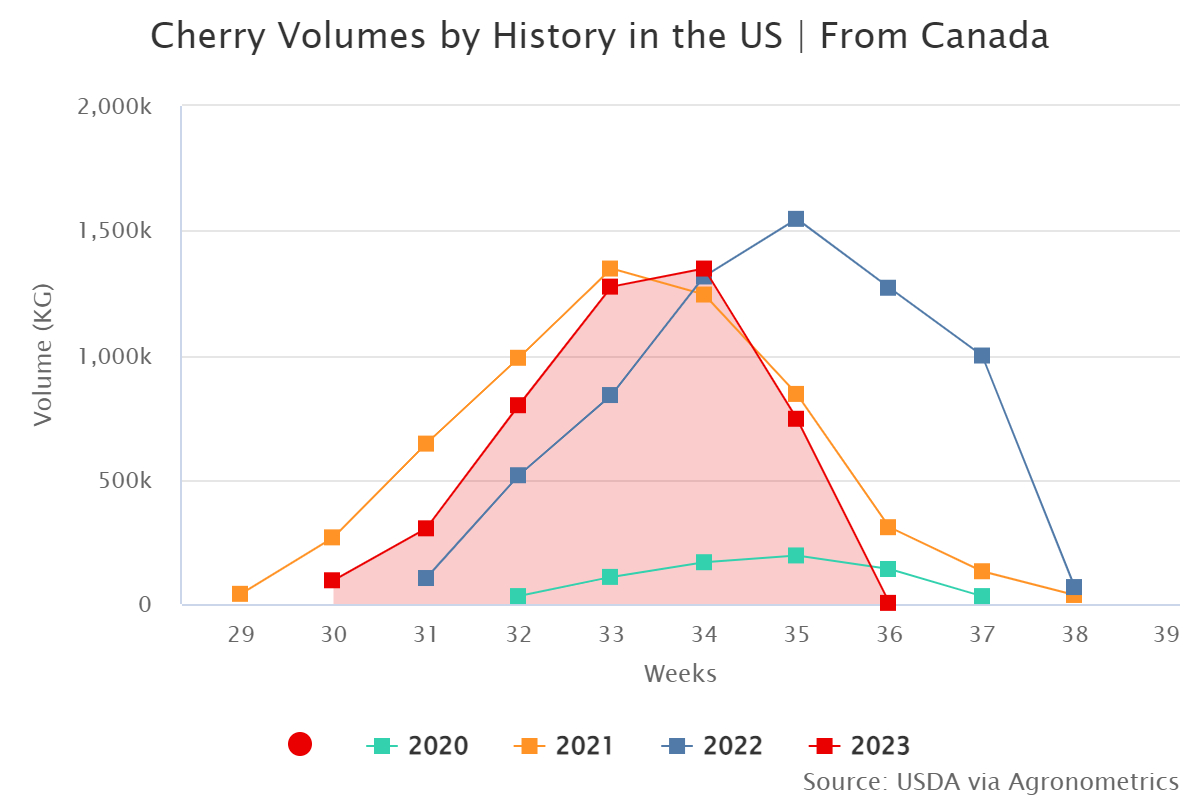A smaller, but impressive cherry crop expected in British Columbia

Overview of cherries from British Columbia in the U.S. market, complemented by charts from Agronometrics. Original published on July 01, 2024.
It’s been a less-than-ideal season for sweet cherry growers in British Columbia this year. Sukhpaul Bal, a cherry grower and president of the B.C. Cherry Association, tells The Packer that this season is one of many ups and downs growers in the Canadian province experienced in the last few seasons.
Though this year’s crop does offer retailers good flavor and color, it’s just not as large of a crop as in years past, he said.
Bal says a polar vortex in 2020 hurt that year’s crop, and from 2020 on Mother Nature has kept cherry growers on their toes. In 2021, the temperature reached 116 degrees Fahrenheit (47 degrees Celsius) on his family’s farm in the Okanagan Valley. The heat not only affected the 2021 crop, but the 2022 buds forming. In 2023, a cold event also impacted some cherry production.

Source: USDA Market News via Agronometrics.
(Agronometrics users can view this chart with live updates here)
Bal says it was a mild winter leading into this season, but within 48 hours the region experienced a major temperature shift to nearly -22 degrees Fahrenheit (about -30 degrees Celsius)
“The trees didn’t have a chance to acclimate to this cold,” he said. “That’s where we saw this huge reduction in volume due to a quick temperature change. We’ve seen that cool temperature before. It’s just how quickly it went from positive mild weather to extreme cold [this time].”
Bal said it’s been tough for the region’s sweet cherry growers who understand the inherent risk of growing stone fruit.
“We know there is risk involved,” he said. “We’re not naive to that and it’s a very delicate crop. We don’t we don’t bank on every single year knocking it out of the park. We know there’s going to be some hiccups, but this past one-to-five-year stretch is nothing like we’ve seen before where there’s quite a bit of damage due to due to these extreme shifts in the temperature.”
Bal says growers have been in communication with the British Columbia province for support. But, the province only reinvests about 2.5% of the GDP generated from agriculture back into the industry.
“That ranks us dead last in the country,” he said, noting his organization and others in the province recognize the need to change that distribution.
This year’s crop
Bal says despite the challenges cherry growers in the province have faced, those who do have a crop this year have good fruit. The volume is limited.
“It’s going to be kind of like a boutique item — pretty difficult to get,” he said. “If they do happen to place some orders of BC cherries, they’re going to be quite happy with the results.”
Retailers, he said, can expect great flavor, color and juiciness.
“What I’ve heard from some growers, they’re quite pleased with what is on the tree quality-wise,” he said.
Bal says British Columbia’s cooler evening temperatures and warm days during the summer help give its cherries a distinct flavor. Plus, British Columbia is home to varieties such as Skeena, Sweetheart, Stella, Staccato and Sentennial.
And unlike last year, where the heat sped up British Columbia’s cherries to overlap with those grown in the U.S., Bal said this year is going to be more spread out.
“I think it’s tracking nicely that even with the little crop that we have, it’ll stay away from other areas and not experience that overlap [this year],” he said. “I anticipate cherries potentially being still available into the mid-August to potentially third week of August.”
The organization plans a marketing campaign to highlight the quality of this year’s crop through social media outreach and promotions.
And growers looking to rebound next year are hoping the buds for next year’s crop were spared from the freeze earlier this year.
The News in Charts is a collection of stories from the industry complemented by charts from Agronometrics to help better tell their story.
Access the original article with this (Link)






